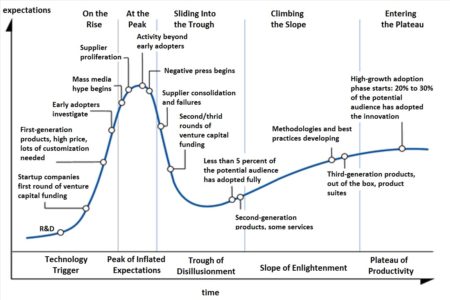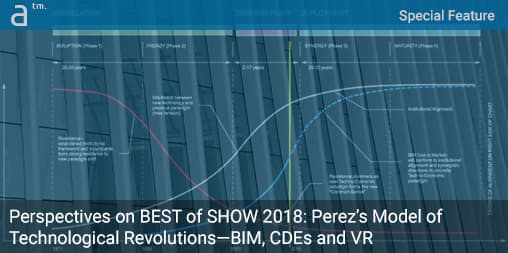[This article has contributions by senior associated editor, Pete Evans, AIA]
LET’S FACE IT if all of us could easily identify technology and social trends we would all be big winners in the stock market and rich beyond belief. Even if that wasn’t our goal—getting rich—as architects and AEC professionals we would at least know how to adopt the right technology solutions at exactly the right time. That too is a big win by any standard measure.
The Point Is—Identify Trends and Take Action
Being able to “ID” emerging trends is a clear way to win in just about any field—providing those with a head-start advantage that can be smartly leveraged. As such, we stated in our first Perspective on Architosh’s AIA BEST of SHOW honors that the primary reason to give nods to the best software and hardware technologies seen at AIA National was to identify “emerging trends” impacting practice in the field of architecture. This helps practicing architects in the following ways:
- discovery — educates them on “new technology-enabled processes” that can enhance their practice
- performance — directs them to “higher-performers” in technology solutions and implementations
- business — providing an analytical framework that endeavors to provide insight from which they can formulate “business decisions” regarding technology in practice
This last point is key. We both hope and expect readers to gain insight that makes their next technology decisions more impactful for their operational goals.
Our Criteria
Our criteria for BEST of SHOW nods is an evolving set of dimensions and frameworks. It is worth recapping this, which we have often called a “lens” in the past. This perspective is a constructed and the developed lens through which technology in the architectural market is measured against both static and dynamic criteria with a particular aim of clarifying, developing, enhancing and ensuring the social value of architects working worldwide in the 21st century.
So in other words, we want to highlight technology that we feel is going to improve the profession of architecture and its impact on society. Tools that allow architects to make more energy-efficient buildings, is a clear-cut example. Tools that help architects save time on non-aesthetic, non-cultural or non-client-facing work are a not-so-clear example. The superpower of an architect is their specific training in technical creativity and problem-solving. Time is an important variable in the output formula of this superpower precisely because “high-quality design” and “problem-solving” demands contemplation and iterative feedback loops.
Therefore, we have placed emphasis on digital tools that modulate practice in a particular set of directions— nonexclusive directions—that conspire to improve the performance role of architects in society.¹ These directions roughly fall into these broad categories which are discussed in full here.
- Social and Democratization of Information Technology
- Computational Power and the Cloud
- Creativity and the Contemplative Pace
While 2013 setup the above criteria framework, in 2014, 2015, and 2016 we layered in other critical dimensions impacting practice now and in the future. You can read those in full by following the links above or by moving forward with our summary below.
- 2013 — we identified the waning relevancy of “design intent” as a legal concept in the architectural world as architects become “fabricators,” etc.
- 2014 — we discussed Phil Bernstein’s long-view of AEC from the era of documentation to the era of BIM to the era of context. For Bernstein, the era of context is about integrating simulation and validation into architectural practice using new tools and methods.
- 2015 — we noted four inter-connected trends: (1) game-ification of architecture, (2) rise of VR, (3) hacking culture and Maker Movement in architecture, and (4) APFD (accessible programming for designers), visual scripting and computational-design.
- 2016 — we layered in the Gartner Hype-Cycle adding temporal context for innovations, introducing terms like “edge-of-reality” and “edge-of-market” to help clarify tech adoption cycles.
We didn’t attend AIA National in 2017 but each year since 2013 we have continuously developed a richer framework from which to forge an intelligent discourse about information technologies in the AEC industry and the impact for architects in society.
During the golden age of mass production, in the 1950s and early 1960s, the interests of business and society converged.
This year we are widening our perspective by introducing the compelling theory-model by economic historian Carlota Perez and her landmark work understanding “technological revolutions” in the broadest sense and their specific impact on societies via her concept of Techno-Economic Paradigms (TEPs). Here is a brief introduction to the significance of Perez from the preface of the book, “Techno-Economic Paradigms: Essays in Honour of Carlota Perez” by Wolfgang Dreschler, Rainer Kattel, and Erik S. Reinert.
By now, this has been widely noticed in scholarship and media, by large corporations, governments, and supranational organizations, and NGOs alike, and Carlota has attracted what could almost be called a cult-like following. Well beyond her home base of Evolutionary Economics, we see the economic world, as it is really unfolding, with our eyes because of her theory of Techno-Economic Paradigms (TEPs)—there are few economists today about whom this can be said.
Adding to our lens the economic framework of a famed but obscure economist may seem an unnecessary overreach to our efforts; however, we think otherwise but in the end, the reader here can judge. Regardless, we are excited to share our Perspective this year.
Part 1: From Hype-Cycle to Carlota Perez’s Technological Revolutions
For 2018 we have layered over a “new” larger technology and social model of analysis, as generated by economist and technology historian and theorist, Carlota Perez. A professor at the London School of Economics (LSE) and elsewhere, Perez offers a long-wave theory about technological revolutions, financial capital and the social change all conspire to form unique, time-defined, “Techno-Economic Paradigms” (TEPs) that unfold as a result of interdependences among the three. We find her long-wave theory compelling and we think you will enjoy understanding and thinking about it, regardless of its bearing on AEC technologies.

01 – This image shows the Gartner Hype-Cycle under the long-wave Technology Revolutions and TEP model by Carlota Perez. Their interaction, as models, is critically decisive in the pace, take-up, and overall success and impact of any given new technology or innovation.
What is important about her theory model—as we will eventually explain in a moment—is that the relevancy of any innovation and its internal advancement trajectory is ultimately under a stronger force bearing down on all innovations within any Techno-Economic Paradigm. We conjecture that a specific curvature of the Hype Cycle—for any given innovation—has its own “shape signature” depending on its alignment with larger synergistic directions set by an overarching technological paradigm shift. (see image 01) In other words, one cannot apply the Gartner Hype-cycle model in a static way to every single new technology innovation—as if the influence of “time” was constant even with respect to financial, social and institutional dynamics. (see image 02) There is a relationship, a kind of gravitation force, that bends that curve across both its x and y-axes throughout the life of the innovation—ultimately altering the pace, market take-up, and overall success and impact of any given technology innovation.
From Little Picture to Big Picture
Perez refers to this force in two ways. “Each technological revolution results from the synergistic interdependence of a group of industries with one or more infrastructure networks.” (Perez) This means that any new technology innovation is under the influences of infrastructure networks that exist at the time of the new innovation. The automobile would have been of little use if roads and turnpikes had not already gone before—both products from earlier technology revolutions. Secondly, Carlota Perez speaks about how disruptive innovations, when accompanying a “facilitating infrastructure,” eventually must “overcome existing organizational models of how things get done” before they coalesce into a new “common sense” way of doing things. There is a cultural battle between the old common sense and the new emerging common sense that is eventually solved via powerful inclusion-exclusion mechanisms.

02 – The Hype-cycle, made famous by Gartner is a “little picture” way of seeing and thinking about a particular technology innovation. A larger picture way is understanding this model under the “big picture” model of Techno-Economic Paradigms (TEPs) advanced by Carlota Perez. See the merger of this curve within the TEP model in image 01. (Image: Wikipedia Commons.)
The Gartner Hype-Cycle focuses on the innovation at hand by way of its publicity, rise of competitors, the rate of funding, consolidation of competitors, and overall adoption rates. (see image 02) However, it does not take this curve up against an overarching “technology revolution” model and relate it to existing infrastructure and alignment (or divergence) from that model. The Hype-Cycle, therefore, while useful, is far less useful than a larger model such as Perez’ Techno-Economic Paradigm theory.
As we move through this article we will try to apply AEC IT innovations to a combined model that looks not just at the Hype-Cycle as we have done in the past (see 2016 Perspective article here) but at where this curve is being “pulled” or “stretched” by our sense of the overall Techno-Economic Paradigm shift emerging before us. (see image 03 – 04 next page)
next page: Part 2: Technological Revolutions: Explaining Carlota Perez’s Theory (or Model)




Reader Comments
Comments for this story are closed